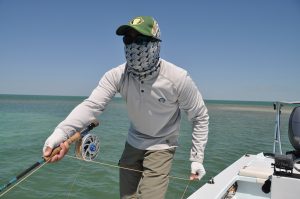April 07, 2017
By Florida Sportsman
Basic tips on how to move the food.
 A long, smooth draw on the line slides the fly forward, perfect for tarpon.
A long, smooth draw on the line slides the fly forward, perfect for tarpon.
What's the ideal stripping cadence? Mostly, it depends on the species you're seeking and the fly pattern you're using.
First, the basics: Learn to use both your stripping hand and rod hand correctly.
In essence, the index finger (sometimes the middle finger, too) of your rod hand serves as a stripping guide through which you pull fly line to strip the fly.
Many bass and panfish anglers manipulate the fly with the rodtip, but in salt water, you should strive to keep your rodtip pointed straight at the fly, to avoid slack line which can hinder hooksets. (A Passion for Tarpon author Andy Mill makes a good case for a little “rod shake” when fishing flies built with marabou or rabbit strip: “I slide the fly forward . . .with a long, smooth stroke with my stripping hand. But I create the undulating movement I want my fly to make with my rodtip through my rod hand.”) For most situations in salt water, your stripping hand alone will suffice.
After casting, I lower my rodtip to the surface of the water (with sinking lines, just barely into the water). To move the fly, I grasp my fly line between the thumb and index finger of my stripping hand immediately behind the index finger of my rod hand. When I strip, I apply slight tension to the line by squeezing together my index and next finger. This keeps my fly line “in check” between strips so that in the event a fish makes a grab while the fly is motionless, it doesn't simply pull out loose line before I can re-grab the line to strip again. Another option is to snub the line between your index finger and the underside of the rod grip. Either method keeps you tight to the fly, and you will detect those subtle pickups as well as be in good position to apply a solid strip-strike to set the hook.
This is good habit whether you are sight-casting or blind-casting, and particularly when allowing a fly to sink deep before starting to strip. I have watched a partner cast a fly with a sinking line and stand there with his hand at his side only to have a fish eat and pull two feet of loose fly line before he reacted. Result: lost fish.
General Stripping Cadences
>Snook and tarpon under bridges at night: I normally cast down and across the current. When I strip my fly, I make mostly long draws, slow and even, 6-inch to 1-foot pulls on the line to swim the fly. Once downcurrent of my position, I keep the line snubbed (as described above) to allow the current to pull my fly along against a tight line.
>Dock lights for snook, tarpon or trout: Short, repeated inch-long strips get the job done. The fly looks like a minnow afraid for its life! Other times, slow, 3- to 4-inch draws work. Some nights, dead-drifts are best.
>Clouser Minnows, crab patterns and many bonefish shrimp patterns: Perfect examples of flies that get eaten on the free fall more often than not.
>On the flats: Too many of us strip too much and too fast for bonefish, redfish and permit. In water over a foot deep where mostly cruising fish are encountered, gauge the traveling speed of the fish, get the fly in the fish's path, “bump” the fly slightly to get the fish's attention and then, stop! Let the fly drop. On the flats, most fish are accustomed to prey that dashes to bottom in an attempt to burrow in sand or mud, or hide in seagrass. If the pursuing fish lowers its head and puts on the brakes, or “lights up,” make a long draw on the line. If you come tight, strip strike without moving the rodtip much.
In the event that a flats fish is cruising along at a good clip, your best bet is too get the fly in its path, and then strip to match the fish's forward speed.
>Pompano, mackerel and other speedy fish: Fast, erratic stripping can seal the deal. Quick, 6-inch to 1-foot pulls are great for macks, but in the case of pompano, think like a jig fisherman. Make two or three fast 6-inch pulls, and then pause to allow a weighted fly to sink. Pomps hits jigs on the free-fall, so expect this to happen with a fly, too.

